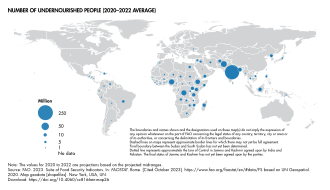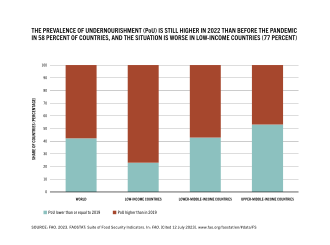
A | B | C | D | E | F | G | H | CH | I | J | K | L | M | N | O | P | Q | R | S | T | U | V | W | X | Y | Z | 0 | 1 | 2 | 3 | 4 | 5 | 6 | 7 | 8 | 9
| Malnutrition | |
|---|---|
 | |
| Underfed child in Dolo Ado, Ethiopia, at an MSF treatment tent | |
| Specialty | Critical care medicine |
| Symptoms | Problems with physical or mental development; poor energy levels; hair loss; swollen legs and abdomen[1][2] |
| Causes | Eating a diet with too few or too many nutrients; malabsorption[3][4] |
| Risk factors | Lack of breastfeeding; gastroenteritis; pneumonia; malaria; measles; poverty; homelessness[5] |
| Prevention | Improving agricultural practices; reducing poverty; improving sanitation; education |
| Treatment | Improved nutrition; supplementation; ready-to-use therapeutic foods; treating the underlying cause[6][7][8] |
| Medication | Eating food with enough nutrients on a near daily basis |
| Frequency | 821 million undernourished / 11% of the population (2017)[9] |
| Deaths | 406,000 from nutritional deficiencies (2015)[10] |
Malnutrition occurs when an organism gets too few or too many nutrients, resulting in health problems.[11][12] Specifically, it is "a deficiency, excess, or imbalance of energy, protein and other nutrients" which adversely affects the body's tissues and form.[13] Malnutrition is not receiving the correct amount of nutrition.
Malnutrition is a category of diseases that includes undernutrition and overnutrition.[14] Undernutrition is a lack of nutrients, which can result in stunted growth, wasting, and underweight.[15] A surplus of nutrients causes overnutrition, which can result in obesity. In some developing countries, overnutrition in the form of obesity is beginning to appear within the same communities as undernutrition.[16]
Most clinical studies use the term 'malnutrition' to refer to undernutrition. However, the use of 'malnutrition' instead of 'undernutrition' makes it impossible to distinguish between undernutrition and overnutrition, a less acknowledged form of malnutrition.[13][17] Accordingly, a 2019 report by The Lancet Commission suggested expanding the definition of malnutrition to include "all its forms, including obesity, undernutrition, and other dietary risks."[18] The World Health Organization[19] and The Lancet Commission have also identified "he double burden of malnutrition", which occurs from "the coexistence of overnutrition (overweight and obesity) alongside undernutrition (stunted growth and wasting)."[20][21]
Prevalence

It is estimated that nearly one in three persons globally has at least one form of malnutrition: wasting, stunting, vitamin or mineral deficiency, overweight, obesity, or diet-related noncommunicable diseases.[22] Undernutrition is more common in developing countries.[23] Stunting is more prevalent in urban slums than in rural areas.[24] Studies on malnutrition have the population categorised into different groups including infants, under-five children, children, adolescents, pregnant women, adults and the elderly population. The use of different growth references in different studies leads to variances in the undernutrition prevalence reported in different studies. Some of the growth references used in studies include the National Center for Health Statistics (NCHS) growth charts, WHO reference 2007, Centers for Disease Control and Prevention (CDC) growth charts, National Health and Nutrition Examination Survey (NHANES), WHO reference 1995, Obesity Task Force (IOTF) criteria and Indian Academy of Pediatrics (IAP) growth charts.[25]
In children
The prevalence of undernutrition is highest among children under five.[24] In 2021, 148.1 million children under five years old were stunted, 45 million were wasted, and 37 million were overweight or obese.[26] The same year, an estimated 45% of deaths in children were linked to undernutrition.[26][5] As of 2020[update], the prevalence of wasting among children under five in South Asia was reported to be 16% moderately or severely wasted.[24] As of 2022[update], UNICEF reported this prevalence as having slightly improved, but still being at 14.8%.[27] In Asia, India has one of the highest burden of wasting with over 20% wasted children.[28] However, the burden of undernutrition among under-five children in African countries is much higher. A pooled analysis of the prevalence of chronic undernutrition among under-five children in East Africa was identified to be 33.3%. This prevalence of undernutrition among under-five children ranged from 21.9% in Kenya to 53% in Burundi.[29] In Tanzania, the prevalence of stunting, among children under five varied from 41% in lowland and 64.5% in highland areas. Undernutrition by underweight and wasting was 11.5% and 2.5% in lowland and 22.% and 1.4% in the highland areas of Tanzania respectively.[30] In South Sudan, the prevalence of undernutrition explained by stunting, underweight and wasting in under-five children were 23.8%, 4.8% and 2.3% respectively.[31] In 28 countries, at least 30% of children were still affected by stunting in 2022.[32]
Vitamin A deficiency affects one third of children under age 5 around the world,[33] leading to 670,000 deaths and 250,000–500,000 cases of blindness.[34] Vitamin A supplementation has been shown to reduce all-cause mortality by 12 to 24%.[35]
In adults
As of June 2021, 1.9 billion adults were overweight or obese, and 462 million adults were underweight.[26] Globally, two billion people had iodine deficiency in 2017.[36] In 2020, 900 million women and children had anemia, which is often caused by iron deficiency.[37] More than 3.1 billion people in the world – 42% – were unable to afford a healthy diet in 2021.[38]
Certain groups have higher rates of undernutrition, including elderly people and women (in particular while pregnant or breastfeeding children under five years of age). Undernutrition is an increasing health problem in people aged over 65 years, even in developed countries, especially among nursing home residents and in acute care hospitals.[39] In the elderly, undernutrition is more commonly due to physical, psychological, and social factors, not a lack of food.[40] Age-related reduced dietary intake due to chewing and swallowing problems, sensory decline, depression, imbalanced gut microbiome, poverty and loneliness are major contributors to undernutrition in the elderly population. Malnutrition is also attributed due to wrong diet plan adopted by people who aim to reduce their weight without medical practitioners or nutritionist advice.[41]
Increase in 2020

There has been a global increase in food insecurity and hunger between 2011 and 2020. In 2015, 795 million people (about one in ten people on earth) had undernutrition.[9][42] It is estimated that between 691 and 783 million people in the world faced hunger in 2022.[43] According to UNICEF, 2.4 billion people were moderately or severely food insecure in 2022, 391 million more than in 2019.[44]
These increases are partially related to the ongoing COVID-19 pandemic, which continues to highlight the weaknesses of current food and health systems. It has contributed to food insecurity, increasing hunger worldwide; meanwhile, lower physical activity during lockdowns has contributed to increases in overweight and obesity.[45] In 2020, experts estimated that by the end of the year, the pandemic could have double the number of people at risk of suffering acute hunger.[46] Similarly, experts estimated that the prevalence of moderate and severe wasting could increase by 14% due to COVID-19; coupled with reductions in nutrition and health services coverage, this could result in over 128,000 additional deaths among children under 5 in 2020 alone.[45] Although COVID-19 is less severe in children than in adults, the risk of severe disease increases with undernutrition.[47]
Other major causes of hunger include manmade conflicts, climate changes, and economic downturns.[48]
Type
| External videos | |
|---|---|
Undernutrition



Undernutrition can occur either due to protein-energy wasting or as a result of micronutrient deficiencies.[2][49][26][1][3][50][51] It adversely affects physical and mental functioning, and causes changes in body composition and body cell mass.[52][53] Undernutrition is a major health problem, causing the highest mortality rate in children, particularly in those under 5 years, and is responsible for long-lasting physiologic effects.[54] It is a barrier to the complete physical and mental development of children.[51]
Undernutrition can manifest as stunting, wasting, and underweight. If undernutrition occurs during pregnancy, or before two years of age, it may result in permanent problems with physical and mental development.[1][50] Extreme undernutrition can cause starvation, chronic hunger, Severe Acute Malnutrition (SAM), and/or Moderate Acute Malnutrition (MAM).
The signs and symptoms of micronutrient deficiencies depend on which micronutrient is lacking.[2] However, undernourished people are often thin and short, with very poor energy levels; and swelling in the legs and abdomen is also common.[1][2][50] People who are undernourished often get infections and frequently feel cold.[2]
Micronutrient undernutrition
Micronutrient undernutrition results from insufficient intake of vitamins and minerals.[26] Worldwide, deficiencies in iodine, Vitamin A, and iron are the most common. Children and pregnant women in low-income countries are at especially high risk for micronutrient deficiencies.[26][50]
Anemia is most commonly caused by iron deficiency, but can also result from other micronutrient deficiencies and diseases. This condition can have major health consequences.[55]
It is possible to have overnutrition simultaneously with micronutrient deficiencies; this condition is termed the double burden of malnutrition.
Protein-energy malnutrition
'Undernutrition' sometimes refers specifically to protein–energy malnutrition (PEM).[2][56] This condition involves both micronutrient deficiencies and an imbalance of protein intake and energy expenditure.[49] It differs from calorie restriction in that calorie restriction may not result in negative health effects. Hypoalimentation (underfeeding) is one cause of undernutrition.[57]
Two forms of PEM are kwashiorkor and marasmus; both commonly coexist.[11]

Kwashiorkor is primarily caused by inadequate protein intake.[11] Its symptoms include edema, wasting, liver enlargement, hypoalbuminaemia, and steatosis; the condition may also cause depigmentation of skin and hair.[11] The disorder is further identified by a characteristic swelling of the belly, and extremities which disguises the patient's undernourished condition.[58] 'Kwashiorkor' means 'displaced child' and is derived from the Ga language of coastal Ghana in West Africa. It means "the sickness the baby gets when the next baby is born," as it often occurs when the older child is deprived of breastfeeding and weaned to a diet composed largely of carbohydrates.[59]
Marasmus (meaning 'to waste away') can result from a sustained diet that is deficient in both protein and energy. This causes their metabolism to adapt to prolong survival.[11] The primary symptoms are severe wasting, leaving little or no edema; minimal subcutaneous fat; and abnormal serum albumin levels.[11] It is traditionally seen in cases of famine, significant food restriction, or severe anorexia.[11] Conditions are characterized by extreme wasting of the muscles and a gaunt expression.[58]
Overnutrition
Excessive consumption of energy-dense foods and drinks and limited physical activity causes overnutrition.[60] It causes overweight, defined as a body mass index (BMI) of 25 or more, and can lead to obesity (a BMI of 30 or more).[26][2] Obesity has become a major health issue worldwide.[61] Overnutrition is linked to chronic non-communicable diseases like diabetes, certain cancers, and cardiovascular diseases. Hence identifying and addressing the immediate risk factors has become a major health priority.[62] The recent evidence on the impact of diet-induced obesity in fathers and mothers around the time of conception is identified to negatively program the health outcomes of multiple generations.[63]
According to UNICEF, at least 1 in every 10 children under five is overweight in 33 countries.[64]
Classifying malnutrition
Definition by Gomez and Galvan
In 1956, Gómez and Galvan studied factors associated with death in a group of undernourished children in a hospital in Mexico City, Mexico. They defined three categories of malnutrition: first, second, and third degree.[65] The degree of malnutrition is calculated based on a child's body size compared to the median weight for their age.[66] The risk of death increases with increasing degrees of malnutrition.[65]
An adaptation of Gomez's original classification is still used today. While it provides a way to compare malnutrition within and between populations, this classification system has been criticized for being "arbitrary" and for not considering overweight as a form of malnutrition. Also, height alone may not be the best indicator of malnutrition; children who are born prematurely may be considered short for their age even if they have good nutrition.[67]
| Degree of PEM | % of desired body weight for age and sex | ||||||||||||||
|---|---|---|---|---|---|---|---|---|---|---|---|---|---|---|---|
| Normal | 90–100% | ||||||||||||||
| Mild: Grade I (1st degree) | 75–89% | ||||||||||||||
| Moderate: Grade II (2nd degree) | 60–74% | ||||||||||||||
| Severe: Grade III (3rd degree) | <60% | ||||||||||||||
| SOURCE:"Serum Total Protein and Albumin Levels in Different Grades of Protein Energy Malnutrition"[58] | |||||||||||||||
Definition by Waterlow
In the 1970s, John Conrad Waterlow established a new classification system for malnutrition.[68] Instead of using just weight for age measurements, Waterlow's system combines weight-for-height (indicating acute episodes of malnutrition) with height-for-age to show the stunting that results from chronic malnutrition.[69] One advantage of the Waterlow classification is that weight for height can be calculated even if a child's age is unknown.[68]
